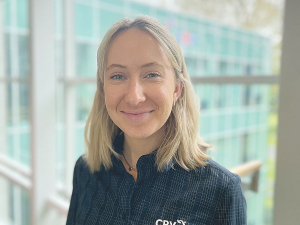Ensuring your cows have the best mating this season
Hit the ground running this mating with these foundations for success.
 The potential for farmers to use DNA to breed healthier, more efficient cows faster is exciting, says CRV myDNA product manager Anna Morrow
The potential for farmers to use DNA to breed healthier, more efficient cows faster is exciting, says CRV myDNA product manager Anna Morrow
Using DNA to identify the unique make-up of a dairy cow will become an increasingly powerful tool for dairy farmers as they look to fast-track the genetic gain of their herds, says new CRV myDNA product manager Anna Morrow.
The potential for farmers to use DNA to breed healthier more efficient cows faster is exciting says Anna, who started in her new role at the end of March.
“Farmers can improve their results by using genomics to select better animals in their herd and by using the technology to make more informed breeding decisions,” says Anna.
The technology is becoming increasingly accessible and, in the future, could help farmers respond to challenges such as reducing their environmental footprint.
“More farmers are DNA testing their young stock which will allow them to better predict the performance of their cows over a lifetime. Currently traits such as polled [without horns] are available, and in the future, we could predict other traits such as low methane.”
The practical application of genetics and its potential to solve problems is what encouraged Anna to switch from neuroscience to genetics at the University of Otago.
“Every living thing has DNA. It tells you everything about that animal or plant, how it grows, develops and functions. Genomics is a really new technology, there is still so much to learn.”
Anna’s unique blend of on-farm experience and knowledge of the complex world of genetics will help in her role managing and developing CRV’s DNA testing service.
Anna grew up on a farm in Gordonton, near Hamilton, and has worked as a relief milker. After university she worked as an embryologist where she created embryos to help provide the top bulls of the future. She then started at CRV last year coordinating the delivery of myDNA before being promoted to manager.
Anna encourages farmers to jump on board with DNA technology to ensure they have access to the best future genetic solutions.
“CRV’s myDNA uses technology that is future-proofed. We use a high-density chip that can capture the unique DNA points to detect genetic variation in cows and as we learn more about those points the predictions will become more powerful.”
NZAEL’s intention to include genotypes into its evaluation system by December 2022 further highlights the industry’s shift towards genomics.
“It’s fascinating seeing genetic technology being used to strengthen the agriculture sector and allowing farmers to achieve genetic gain faster.
“It’s great being a part of that and I can’t wait to see where we head to next,” says Anna.
“Looking overseas to farmers in Netherlands and other parts of Europe, they already select based on genomic information alone and more farmers will start doing that in New Zealand. Now is the time to get young stock in the system – once tested you can track those animals for life.”
For more information on myDNA visit crv4all.co.nz
More than 150 people turned up at Parliament recently to celebrate the 20th anniversary of Horticulture New Zealand (HortNZ).
Biosecurity New Zealand says Kiwis should continue to keep an eye out for yellow-legged hornets (Vespa velutina) over the holiday season.
The Push-Up Challenge, an event which combines mental health and fitness, is set to launch in New Zealand in 2026.
Last month's Agritechnica event led to a wide group of manufacturers celebrating successes when the 2026 Tractor of the Year Competition winners, selected by a panel of European journalists, were announced in Hanover Germany.
According to the latest Federated Farmers banking survey, farmers are more satisfied with their bank and less under pressure, however, the sector is well short of confidence levels seen last decade.
Farmer confidence has taken a slight dip according to the final Rabobank rural confidence survey for the year.